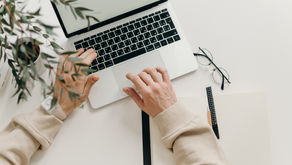Week 7: Global Studios
- Tramaine Berry
- Jul 12, 2021
- 7 min read
Updated: Sep 27, 2023
Research and analyse approaches and strategies for working today and delivering creative services as a graphic designer;
Imagine new models of practice that help you grow and develop throughout this course;
Imagine what media and communication platforms could help support your potential new models of practice;
Design and communicate a one minute elevator pitch outlining how you can work in new and more exciting collaborative ways;
Manage your independent learning effectively.
LECTURE //
Collaboration Around the Globe
Lecture 1: Ken Kirton
According to Ken Kirton, graphic design education use to be mainly designing poster, books and typefaces on screen, and his forward thinking tutor ran a practise called OBake, which got involved in local communities, museums and galleries. I couldn't find the tutor's audio but I did manage to find out that Obak is part of Japanese folklore that translates to shapeshifters, so I think the tutor has definitely make an influence in the interest in Japanese culture. Obake is usually celebrated during mid-August, which honors the deceased spirits of one’s ancestors.

Ken set up Hato press in 2009 to support the community of practise, which is an independent printing and publishing house that encourages collaborators to develop ideas. He sees the Hato Press as a design tool to help other individuals be more creative, or think in a different way - the tool supports their set of values of education, craft and community.
The decision to have a studio based in Honk Kong was due to workload that required more than just remote based in London. Everything is in the cultural sector. Number of tools today like WhatsApp enable people to communicate frequently in different timezones - they are still working out the communication process though.
Hato means ‘pigeon’ in Japanese because they wanted to create a link between Japanese culture and how their practise is structured; Japan is a community driven society as well as their sense of pride in their work.
New Studio also have two different time zones.
They mention the idea of how co-design/ co-creation can have a disconnected effect because Boaty McBoatface was a name chosen by the public, but it is a research vessel. However, he does mention Adidas’s co-creation campaign. Is it better to co-create because Ive been thinking of getting dyslexic designers to collaborate over the branding process.
Hato Student Society supports communities in education, which is a free platform for portfolio reviews, printing workshops in London and discounts on printing bills.
Lecture 2: New Studio
Rita Matros and Axel Peemoeller are both from New Studio, which is made up from a collection of freelance designers from various backgrounds and fields. This allows clients a more rounded skillset as well as being available for clients on a 24 hour basis. The freelancers enter New Studio through their skillset and connections, which means the studio is gaining new clients - and they are encouraged to continue o grow their reputation in their local area. The main communication tool is Skype, which allows them to share their screen, schedule meetings and share files.
Rita mentions she approaches clients in a different way now she is with New Studio because she doesn’t need to say no to clients; she can balance out her workload with her team. And she is also able to offer her clients more skills.
Lecture 2: The Future of Graphic Design Globally
How will globalisation and advancements in technology affect graphic design education?
Someone - When you travel, you meet people that do things in a different way and have a different way of working and living, and this allows you to collaborate with different people. Look for examples - studios, university placements.
The design sector is starting to meet other sectors and influence creative thinking. Technological advancements allow you to get stuff done faster, which allows you to take the Minimal Viable Products approach - proving that the concept works, which allows the clients to see your way of thinking before dismissing it or changing it.
Sarah Boris - Social Media gives us an opportunity to connect with clients, however, whilst technology has given us a cheaper alternative to connect with clients (great for start-ups), it’s also raises the risk of damaging mental health. I see where her point is, I am currently doing a remote job and studying remotely, so I make sure to have one social day with family or friends. Have a look at mental health cases during lockdown; people would be doing full-time jobs remotely or studying.
How does technology affect design education? How can we embody information in a non-technological way that is usually done on-screen? How do humans learn?
What do you think the creative opportunities are for students studying on global online course, such as the MA Graphic Design at Falmouth?
The idea that is a global course, encourages more cultural connections and informs the way other people perceive design. It also creates opportunities to collaborate with people that have the same interests as you.
Is it better to collaborate with people face to face or online?
WORKSHOP CHALLENGE //
Based on some of the debates and discussion covered so far, outline a series of ideas that could help you to work in new and more exciting collaborative ways.
What media and communication platforms could help support this? (This might be to help you collaborate with new design partners, introduce yourself to a new network or culture or area of investigation.)
Present your ideas as a one minute elevator pitch video (with the aim that you will develop one of those ideas further next week).
what collaborative platforms already exist? Instagram, slack, Skype.
How could I create something that helps me collaborate with new design partners and provide some kind of introduction to a new culture or network, or even an area of investigation. I know collaborative tools are more than just apps, so I need to think of physical collaborative tools as well. How could I bring people from around the world to be involved in my practise alongside me?
Proposals
Building on my brief 1, I want to go into more detail on how my business will be run, however, there are different sides to my proposed business.
1. I can either design a platform that allows creative employees to collaborate and gain advise for their workplace.
2. Or I could design a platform/ system for the marketing/promotional side of my business that caters for learning difficulties.
3. Or design a system for how I am going to run the consultancy side of my business and collaborate with employers
Im learning towards the marketing one just because it would be a reflection on my current workplace and how the remote system is run.
Clarification
A comment on the ideas wall have suggested that I should make my proposals less corporate and more public based? I did say I was leaning towards the second option, so maybe they were referring to the idea that I should not cater the platform for my business plan alone but make it a platform/ system that people could use in their own businesses? So I would be helping businesses cater for the needs of their employees and the way they process.
Proposals
Concept 1 - Collaborative platform for people with learning difficulties
This builds on this idea I had from brief 1. The idea is to meet people that experience workplace frustrations similar to your own, which increases self-understanding and self-esteem.
Would they only be creatives?
Could this platform be interdisciplinary? This would allow people to inform their projects and people can switch skills.
Would there be public exhibitions to show children with earning difficulties can be in any field? Where would funding come from?
What kind of projects would be created?
Concept 2 - Workplace platform catered for learning difficulties
This would be for remote working as this has become a normality during Covid-19 lockdowns, and is likely to remain popular post-covid; some businesses no longer have offices due to 2020's economic climate and many start-up businesses would see this as a cheaper alternative overall.
Problem? Difficult navigation, the need to use different platforms.
Ideal Solutions? Everything is in one place. To do lists.
What industries would be using this?
What if businesses collaborated with each other? Is there a transparent way for them to work with each other?
Concept 3: Anxiety in the workplace
Fight or flight
Notes:
Overwhelmed and get too scared to make the first step (flight). Sometimes I feel that I go through this stage during the development stage of my projects because Im scared of getting it wrong. It's like looking from the top of a waterfall and being pressured to jump into the unknown.
Anxiety about not being right, so would cause arguments (fight).
I have found I cause arguments in my workplace lately due to not wanting to be wrong about how Ive approached something
Knowing how dyslexia affects you is the first step to a solution. Meditation help disconnect mind from body - see feelings without brain interfering with. Take focus out of your mind.
Slowed down. Dyslexic brains are fast, so they need to slow down ignorer to avoid burning out . He references the mind to a computer overheating.
Concept 4: Two-way communication in the workplace
Based on the interview I had with Sarah Green, I found that the most important factor in the workplace is two-way communication between employer and employees. This factor is even more essential when communicating to SpLD people, which is why I am going to investigate how I can communicate or aid this.
What is two way communication?
Examples include the telephone. It creates a more democratic environment where people share their thoughts, ideas and opinions in order to solve problems better.
The effects of communication breakdowns in the workplace can be seen through increased stress levels (52% of respondents), delay or failure to complete projects (44%), low company morale (31%), missed performance goals (25%), and lost sales (18%)
The importance of building opportunities for solid two-way communication – dialogues and conversations – really can’t be underestimated. When our two-way communication is well planned and executed, the benefits to our organizations include:
Heightened levels of job satisfaction by offering an outlet for employee concerns, ideas, opinions
Increased productivity because ambiguity about roles/responsibilities/actions is reduced
Enhanced collaboration across the organization, which can lead to more creativity and innovation
Improved trust between leadership and employees, which builds internal brand loyalty and offers opportunities for continued growth
My brain is visual so a 300 page manual is not the best way for me to learn
I learn by doing and watching, not reading or listening
In other words - 'Show me don't tell me'.
Elevator pitch: Tips


WEBINAR //
Even though I've taken meditation classes and have recently started picking it up again during my new job, this new breathing exercise in the lecture seems to be very effective.

Loosen your jaw when presenting because stress is stored there.. might explain why I want food when I'm stressed or turn to alcohol
When presenting, start off with a startling statement, incident, story, question or quote. Get people interested
Sell the why not the product
Pull on emotions
Summary repeats main points
STUDIO PRACTICE PDF -
present like an elevator pitch rather than cram blog in a pdf
Half the pdf would be imagery or elements/ shapes
Make a content page
Critical reflection- key learnings in the module and improvements
Elevator Pitch (final piece)
REFERENCES //
Lecture
Obake in Japanese Popular Culture. August 12, 2016. All About Japan. https://allabout-japan.com/en/article/3827/











Comentarios